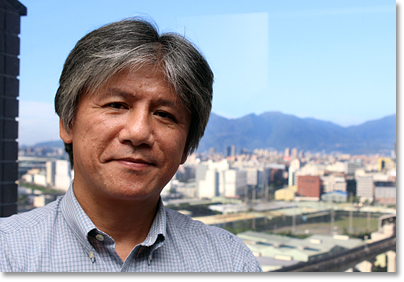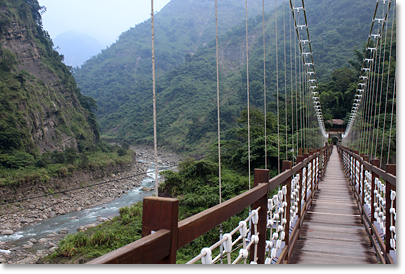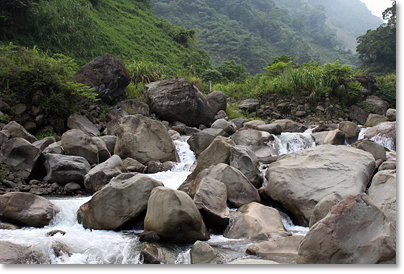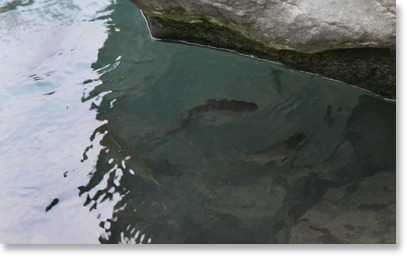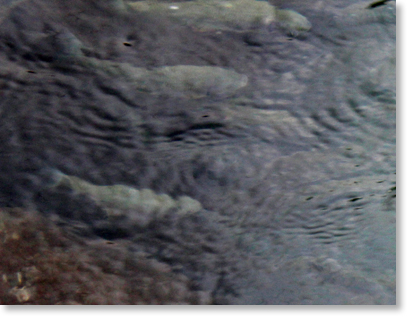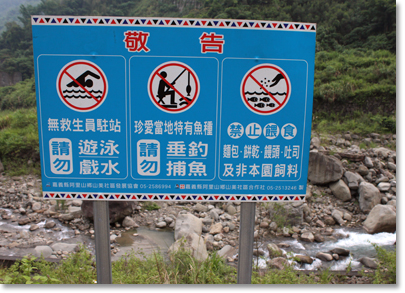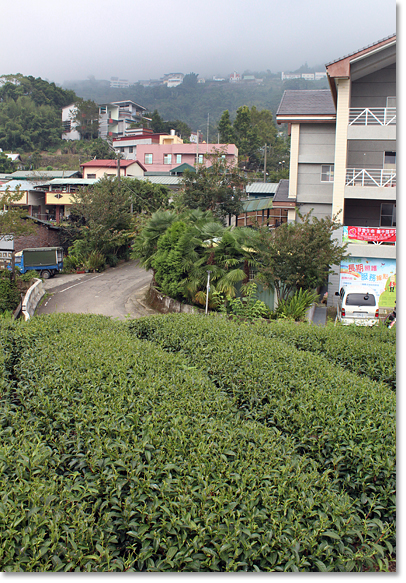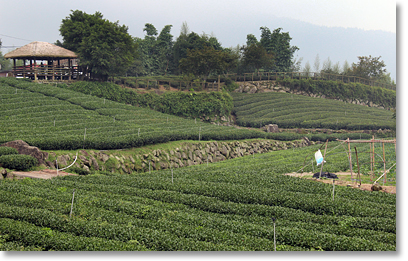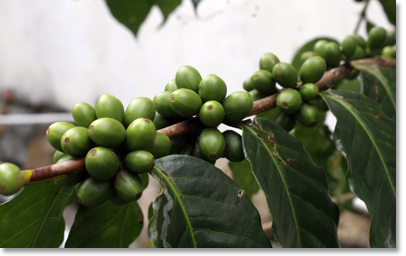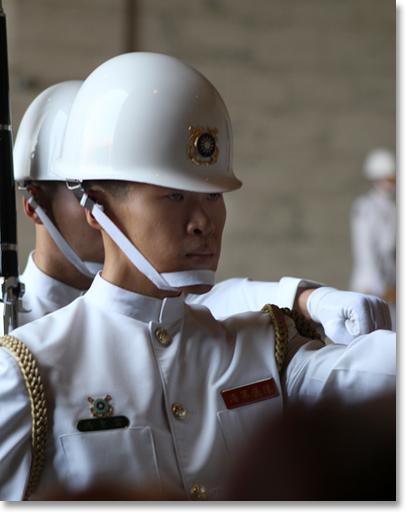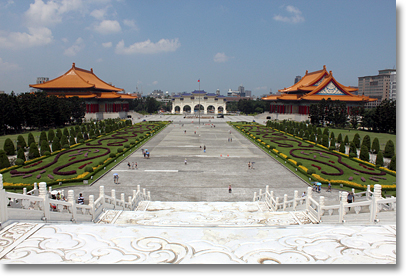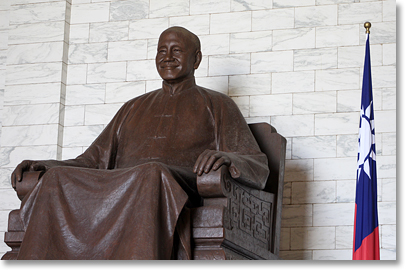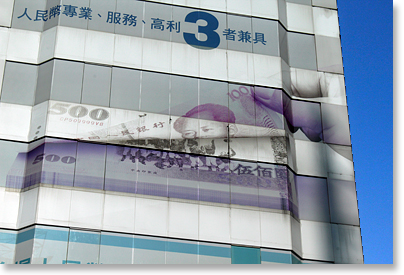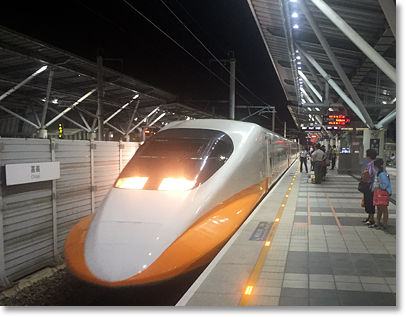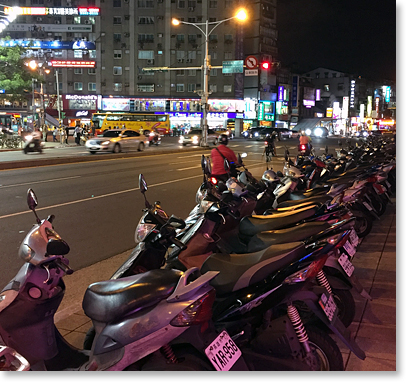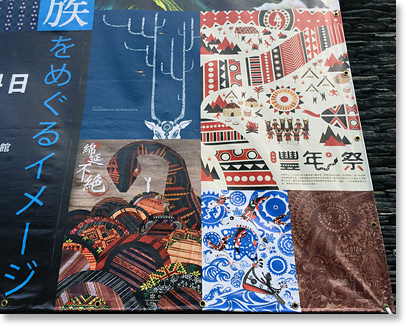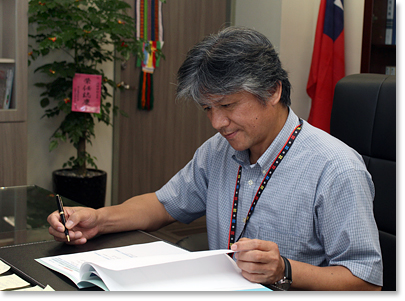|
Interview with tibusungu 'e vayayana
This interview was conducted and later edited by Nic Paget-Clarke for In Motion Magazine on August 22-23, 2016. The interview took place in the deputy minister’s offices in the Ministry of Culture, Taipei, Taiwan (Republic of China.) Quick Links:
Part 1: There was a huge social change In Motion Magazine: Can you talk about your upbringing; how you became a teacher while at the same time you were involved in the Indigenous people’s movement in Taiwan? tibusungu 'e vayayana: I grew up in my homeland, in the mountains. Taiwan is a small island. The Tsou people live in a central part of the island of Taiwan. We are a tiny people maybe only seven or eight thousand, but we occupy maybe the highest part of Taiwan. It is a very beautiful and famous tourist site in Taiwan, even internationally. There is a mountain train from the city of Chiayi to Alishan, and that is the name of our place. The tourists all know the name of that place. The mountain train, the railway, was built during the Japanese era, nearly 100 years ago. It’s a very historical railway. The village where I lived/live, the name of the village is Lalauya. It means maple tree. It used to have many, many maple trees, but now it has become a tea garden. Yes. Yes. And, more recently, we grow coffee there. The climate, or environment, is very similar to the coffee area of Central America. But, traditionally, we were a hunting and gathering people. When I was a very small child, my grandpa was the chief or the head of the community, of the village. My father was a teacher in the school. He had his first learning in the elementary school in the Japanese era, so, my father could speak Japanese and my mother could speak a little. I remember when I was an elementary school boy our family was once a very good family. I think from my point of view now it was great. But after I graduated from the elementary school, I moved to the city to junior high. And, when I graduated from the junior high school, my father died. Because my father was a teacher, when he passed away our family became very poor, very poor. But before I left Lalauya, my community, to go to the city Chiayi, I remember the good old days when my grandfather took me to the rivers to fish -- many, many times -- and to set traps. How to catch birds, how to hunt. It was a very happy time in my memory but it was a very short time. My grandpa died, and my father died, and my uncle, and my father’s father died -- one by one, in a very short time. And I know there was a problem at that time. There was very bad alcoholism in the village – you know that? – and, as I think now, there was a huge social change because of civilization, modernization, directed by the government. Yes -- because we are different people from the main society. We speak a different language. We have a different culture, living a different way of life. The older generation, I think, from my viewpoint, they could not make a good adjustment to that change. So alcoholism came as a common story in the communities. Many children lost their fathers, their elders, their uncle. So we have to face, ourselves, the change, the continuing change. I can still speak (my language) Maybe I was very lucky because before, in elementary school, and even in junior high, I was in a Catholic-sponsored high school. Many children like me got into the school. We stayed together and had the chance to learn -- otherwise we would not have had a school to learn in. The Catholic priest, or Father, was from Germany. He was very kind to our peoples and he helped us a lot, including the children, to get into the school because we were all poor, very poor. We didn’t have money. The family were all poor at that time. But, when we got together (at the school) we could still speak our language in a small campus that was separated from the Han peoples, our schoolmates. It was like a boarding school but we still could speak our language. Because of it, I can still speak. That is why I am so lucky. But later, younger generations, they cannot speak very well, at least not like me. So, my father died when I graduated from junior high and our family became very, very poor and it was a very hard time for my mother, who raised me, five children. She supported me, to go on with my education, so I went on to high school and finished it. The first year, I didn’t really want to because I knew my mom ... we were very poor. I can’t hardly imagine how she could go through it. It was so difficult. But she really supported me, to go on with my education. Eventually I finished and got into the university, NTNU, the National Taiwan Normal University. The “Normal” means it is a teacher-training school. The students who graduated from the university became teachers in high school or junior high. That’s my education. Consciousness about being Indigenous peoples In Motion Magazine: How did you get involved with organizing the Indigenous people’s movement? tibusungu 'e vayayana: You know, during my education, until I finished my college, I was a teacher in junior high for four years and did two years of military service. I was in a military school. Until then I did not have the consciousness about being of Indigenous peoples. But, when I graduated from the university, it was 1982, that was the very beginning of the Indigenous movements. I had some friends, not in the same university, who were also Indigenous peoples but of a different tribe. They were the leaders of the students’ organization and they were very good friends so I knew what they were doing. I visited them very often to see what they were doing. Even though I didn’t really understand what they were doing I knew what they were trying to say. And that time was during martial law. People were not really free to speak. Not really free to ... .Protest was strictly forbidden at that time under martial law. The KMT regime and the military office in the campus office of the university until now, you know what they were doing? They were trying to stop different thoughts, I mean different from the government, the KMT. You know the KMT? In Motion Magazine: Yes, the Kuomintang. (Editor: the Kuomintang is a political party originally from mainland China and now in Taiwan. The KMT was formerly led by General Chiang Kai-shek. He was President of the Republic of China in Taiwan under martial law from 1950 to 1975.) tibusungu 'e vayayana: Yes, of course. My friends, I wondered that they dared to do that. It was very dangerous. They were very much criticized by our friends. They criticized them very much but they did not stop. I really wanted to know why. So I came to learn from what they tried to write. Through the papers that they had written I came to know what they were trying to say. It was about our own culture, our language, the extinction, termination of the language and the culture because we are going to lose our language, ourselves. And I agreed with that because at that time our generation still spoke very well, very fluently -- I mean our language. We found that our younger generation, more and more our younger generation couldn’t speak very well. It was a very serious question and I finished military service at the same time as, many times, they went to the street to protest for different issues: like the prostitutes, or the young females being sold into the sex trade, teenagers, slavery. And also (they protested in regards to) a very famous story in history; we call it the Wufong story or Wufong Incident. It was a story during the Qin dynasty. The Wufong Incident This person, Wufong, was the middleman between the government in the Qin dynasty (editor: 221-206 BCE) and the “savage” people (Indigenous business people). He could speak both languages. He could translate the policy of the government, the colonizer, to the people, the “savage” people (such as the Tsou), and get something. He can sell something good from the business people and get the money. And these guys (like Wufong) were always cheating the business people because they (such as the Tsou) don’t understand the language or the laws of the government. These guys get rich from the cheating – if you know what I mean. Finally, they were killed by our people, the Tsou. But the story in the textbooks in the schools was that these guys were very good men, just like a priest trying to teach the “savage” to be civilized. “Stop head-hunting!” -- he wanted to change bad behaviors. You know though, the Indigenous peoples for most of the time when they kill the outsiders it's because they invade their territory. Of course, “If you come into my place and try to rob my land, yes, of course I will defend it. You won’t listen and I kill you. I cut your head off.” So, this guy was not really good from our side. He was a cheater. He really was not a very good person, so we killed him. But the story says, after his death, we have disease on our side. We got sick, very serious disease, just like the Indians in America with the contact with the white man. They got sick and many people died. So, they say, “Because you, the savage people, did not listen to this good man, so your people die. If you had listened to him you would not have had that bad fortune.” The textbooks write about him in a very good way, writing about a very good person, just like a priest, because he converted our bad behavior, changed us, so we are more civilized. But that is not really the truth. At that time we went to the street to protest about the stories, the text in the textbooks. The truth is very different from the textbook. From “Children of the Emperor of Japan” to the "Children of China" And this other one is more about land, land being developed, being confiscated. But it is a very long history from before World War II, 1945, during the Japanese era. The Japanese had many policies in the Japanese era -- Japanese colonization. They set up a reservation area for the Indigenous peoples, only a small part of the traditional territory, which was a very large area with only a small part left for the Indigenous community. Then, when the KMT government came here at the end of the war, they inherited the old policy. Basically, to the Indigenous peoples, they are the same, just the same. So, in the Japanese era, through education and cultural policy they changed us to become “children of the emperor of Japan”. And I think it was really successful because our grandfathers, our fathers, the older generation, they believed they are Japanese because they had been colonized for over 50 years. During World War II, all Indigenous peoples could speak very good Japanese, with the Japanese way of life. They even became soldiers to fight in the Pacific against the Americans. Many Indigenous soldiers, because they believed they should fight for the emperor, were fighting for their country. Unfortunately, they lost the war. Then came the KMT government, the winner of the war in the mainland with Japan. They won after eight years. You know that story? They say, “We had an eight years war with Japan” and finally they beat Japan. “We come as winner.” This new government, they hate the Japanese (but) they inherit everything that was set up in Taiwan, the policy left by Japan, including the land, the reservations. But the difference is they want us to be “the children of China.” They wanted to change us to become a new people, different from “the children of the emperor” after 1945. Very interesting. Three times: a land restoration movement Why am I telling this history? The story is very long. Many things that have happened since 1945, up until the 1980s, were long developed during the Japanese era. It is very complicated, not easy to tell. But I believe it was in that time that we started to think about ourselves, our future, our situation -- those 1980s. And later we had, three times, a land restoration movement. We wanted our land back, our traditional territory. They were very massive movements. And these kinds of protests tell the main societies, and also tell our own Indigenous society, the question or the problem we faced. It was a lesson for both sides. A lesson for the main society, and also we can learn from it, I mean for the Indigenous people. We have so long been colonized. During the 1980s, many people, including me, really believed that we were the children of the Chinese in the mainland, and that is different from the 1940s (when) we were Japanese. After 40 years, in the 1980s, we were a different people. But the truth is we are Tsou. I think the time that we begin to know we are neither Japanese nor Chinese is from the 1980s. Because of the movements of the Indigenous peoples, we began to know who we are. That is what I say -- conscious of our ethnic identity. So, that was my first contact, because of my friends who led these kinds of movements. I just joined. I just followed them. But I had something that I began to think about on my own -- my own peoples and myself. Part 2: A New Learning, a New Movement The geography department In Motion Magazine: And then you were in the geography department? tibusungu 'e vayayana: I graduated from the department and became a geography teacher. You know it’s funny because during college, for four years, I never studied what nowadays we call Indigenous geography. We never learned any geography of our own peoples. Do you know what I mean? In Motion Magazine: Yes. tibusungu 'e vayayana: We all know Chinese geography, the geography of China, in Mandarin. We know every place in mainland China, including Taiwan, and we thought at that time that Taiwan belonged to China. We were the real China and the communist Chinese were not. They are just our enemy. Our capital was not Taipei. We should have our own capital. The capital was Nanjing, before 1945. And every student should remember that, should know the correct answer, “Where is our capital?” “Not Taipei. Taipei is wrong. You should be punished.” Even me, I’ve become a geography teacher but I am of Indigenous peoples and I never had a chance to learn any Indigenous geography, the place names of Taiwan, where we are living, in my own language. Just like this (looking at a book on Taiwan’s Indigenous Culture), Lalauya, we never read about it in a book -- never -- only in Mandarin, and only the geography of China, and Taiwan of course as a part of China. “Our capital is not Beijing, it is Nanjing.” And I taught at that time. I was teaching in two different junior highs: two years in Tainan county, in the countryside; and two years in Taipei when I was a graduate student. It was from 1988 to ’90, two years, and that was about the same time as the protest time. I remember when I taught in Taipei at junior high that I had the feeling, “Why should I worry about you? You don’t understand. You don’t know about your capital in China. Why should Indigenous teachers teach you?” And I didn’t know. I didn’t have any chance to learn about our own geography, our traditional history, like the Wufong story. I only knew about this guy from the textbook you have written from your perspective. What was I doing? I began to think about myself. What I was doing was not really, not good. It’s not good. Why should I worry about the children of Han people who do not understand their country, their geography, their capital. Why should an Indigenous people’s teacher worry about them? I should worry about my younger generation of Indigenous peoples knowing their own story and their land, the geography of their land. I think this is maybe the key point. I decided not to go on with that teaching. Something by ourselves that the government never does So, after I’d gotten my master’s I had a chance to leave and, at that time in 1980, I decided to come to the department of geography and become one of the teachers in the college. After that, I began my new career in research and I had more and more opportunities to think about the Indigenous peoples -- in research and in teaching. Then I went on with my Ph.D. study for nine years, for nine years. You know, this maybe was the most important time of my life, to go really deep into the community in my thinking about our Indigenous peoples. In Ph.D. (study) you have to research something, write papers, so almost all of this was reading or writing about Indigenous peoples -- a little bit different from what I was teaching because I had to teach something which was not really Indigenous. Besides, when I say research, we had to spend much time in the Indigenous community, including in my community. And I went there very often and I began a new learning, a new movement, which is not going to the street to ask government to do something. Rather, I’m going into the community to ask our people to do something about ourselves. We can do something by ourselves that the government never does, that they will never think about. For me, that is also a kind of revolution -- just the same as the point of going to the street to protest. We have to do something to let our peoples know. We have to stay together, come together. We think together, and we talk. Talk about land. What's the problem with our land, our language, our society, including our family, alcoholism? Yeah. Our young generation. Many things. It's amazing, even more complicated than going to the street to ask government to give us something. Reconstruction of ourselves In Motion Magazine: Would you refer to that as being autonomous? tibusungu 'e vayayana: It is something about re-construction of ourselves, reorganization, restoration for autonomy, for self-governance. So, we organized a meeting, like, we are Tsou people. And since 1999, the first year of my Ph.D., I wrote my Ph.D. with this movement to become an activist in my own community, my people. But not only in my community, I also connected with the other peoples. The other tribes. Yes. In Motion Magazine: You prefer to use the word “tribes”? tibusungu 'e vayayana: No. In Canada you say First Nation. Tribe is maybe more ... Maybe nation is better. Not many colleagues would agree with that, but I prefer to use nation because we are building ourselves to become a nation. Tribe may be a natural state of a people. You belong to this tribe, you belong to that tribe, the tribe is about your culture or language. But the nation is about building nationalism. You need a process to become a nation. It’s my understanding about the nation. In the way of Tsou (Anyway), we conducted about ten years of Tsou meetings – meetings of our own peoples. Once a year, we invited the leaders of the community -- not the officers, like me -- the traditional chief’s family and the other important families in the sub-tribe. Actually (as an important aside), we found we are a different sub-tribe. We have our own community. We have our own leaders, traditional leaders, and we have our own ceremony. It is very lucky for my people because we still have our very own traditional ceremony. Basically, we have two traditional ceremonies. One is about war, the war ceremony, we call it mayasvi. The other one is about the millet harvest. We call it homeyaya. Homeyaya means the time to harvest, time to harvest the millet. It is about the summertime. And these two important ceremonies are still held in our community. It is very good for us because, “Oh, we have that tradition”. We never stopped. Even when the Christian church came to my community, even when the new culture came, invaded our community -- we still kept that. So, we invited the eldest from the different families and the new intellectuals, and they came as a Tsou. They did not come as a teacher, or a priest, or a government officer. You just come as a Tsou. “We speak Tsou. We are thinking in the way of a Tsou. We see in the way of a Tsou.” I believe we can only find ourselves the same in that platform. You only become a Tsou if you find we are a community. But we have so long been divided into different political parties, Kuomintang or not Kuomintang, different church, different career, different education. We’ve been divided and been ruled by the outside. We have to work out how to get ourselves back -- to come together again, to come together again. That’s why I say, “We have to have a meeting in the way of Tsou -- meeting like a Tsou, meeting like a Tsou.” It’s different from: we have a meeting about education that is hosted by the principal or by the teachers. They talk about education in schools but that meeting is not about Tsou education because it is about state education, the state school. What I mean is education of Tsou -- we talk about education from the perspective of Tsou. If you talk in the school, you only talk about the six-year-school-time-learning education. It is school education. It is not Tsou education. Tsou education means the whole life of the Tsou, generating, sustaining Tsou education. It’s a whole life. But if you have a meeting in the junior high school with the teachers you only talk about the three-years education. It’s also about the schooling, the state schooling system. Do you know what I mean? It’s different. Our own perspective, our own wisdom We have to come back, move to our home in our language. We can use our language. If you just speak in Mandarin, you really are being colonized by this language. You know what, when I say “was taught”, my colleagues and my friends we were being colonized through the language. We look like Tsou people but, just like a computer, “You are so beautiful, you are so handsome” but when you open up your mouth and you speak not Tsou. Just like a computer: you turn it on, it’s Microsoft operation system; you open up your mouth, it’s Chinese Mandarin operation system. Really, colonizing of the mind and the whole value system, the whole language system. You are Tsou? I don’t believe you. Lucky me, I’m not really good at English speaking, because I still keep the Tsou system, Indigenous system, in my mind, in my body. Hard and software. Many, many of our younger generation only kept one system, one is Mandarin system, one is Microsoft system. This is a metaphor. That is why I say we are all facing this problem. I already told other people, “You say you are Indigenous peoples, tell me, tell me about that. You cannot speak. You don’t want to speak. You like Mandarin. You like English more than your own language. You feel shame when you speak your own language. Why? You should be proud because it’s unique.” So, it’s a building, a reconstruction, a new value of our own. We need to come together. We talk. We don’t think about our interests outside of the community. Maybe you have your work, like I teach at the university. Maybe you work in church. Maybe you are a policeman. Maybe you are a military officer. Maybe you are a Ph.D. or master -- forget about that. Forget about that. Become a Tsou again. We think and talk only in the way of the Tsou. It’s a kind of reconstruction of the old way. How we say? We are re-setting ourselves. You have the virus attacking, not working. You have to re-boot the Indigenous operation system -- something like that. So, that ten years was very important for my life. Many people remember that time. Each year we had that kind of meeting. Maybe it was the only meeting that was really different from the other many, many meetings in the community -- or even in the wider, outer society. Meetings adopted by the outside force or state system: education, economy, social problems from the outside perspective – not our own. We have to build our own perspective, to look into this same question. We will have a different vision, a different understanding. We should have our own perspective, our own wisdom. We can. So, after the ten years, maybe it was around the year 2000, the town changed a lot. More stable than before I didn’t mention about the 1980s. In the 1980s martial law finally ended. The Tsou meeting was during the ’90s decade. Fortunately, in 2000, the KMT finally ended their regime. We changed to a new president with the DPP, the Democratic Progressive Party – that is not Kuomintang. That was a historical point. At the same time, after the Tsou meeting for ten years, after the year 2000, in the 21st century until now, another sixteen years, Indigenous peoples began to expect more change from the new government. And the new government is really different from the old one. The old one (government), to the Indigenous peoples, and even to the other main societies, are all colonizers. Not only did the Indigenous peoples lose their culture and language, but also the Minnan and Hakka of the Han people. They also have been stopped from using their language in school because we can only speak Mandarin. Because, actually, the Han people in Taiwan they still have two other language dialects: the Southern Min province dialect (Minnan) and Hakka. Under the education language policy of the Kuomintang, even (though) they are a very large population, they also faced language loss. All of us in Taiwan could only speak Mandarin when the Kuomintang was in their position. But, since the year 2000, I think it’s changed, started to change, though it’s still unstable. And this year came President Tsai Ing-wen. The DPP came into power again. I think it’s more stable than before. So I decided to join this government. It’s a long story. Part 3: Cosmologies and Social Organization The languages of Taiwan and Austronesia In Motion Magazine: You’ve talked about the various colonizers, but before 1600 it was just the Indigenous people here. Some say that Taiwan was the origin of the Austronesian peoples. Can you talk about that? tibusungu 'e vayayana: Mostly they say this from the linguists’ (perspective). Through the research of language in Taiwan and other Pacific areas, the Austronesian area, they found a very similar language phenomenon, but the most complicated area is Taiwan. You can find each language phenomenon in Taiwan. You can find everything in Taiwan. I say this compared to the vast area of the Pacific area. There are many islands: Melanesia, Polynesia, Micronesia, so many islands. But Taiwan is very complicated. You can find many different language phenomena (here). When I say phenomena I mean vowels and consonants. You can find all of the phenomena of the vast area of the Pacific -- you can find all of them in Taiwan. What I’m understanding is that they believe that Taiwan is, maybe, one of the origins of the Austronesian language, (editor: there are over a thousand Austronesian languages including Indonesian, Malaysian, Filipino, Vasayas languages, Ilocano, Maori, Malagasy, Hawaiian, Fijian, Taiwan's languages and others). “Taiwan is the origin of the Austronesian people.” I don’t really believe that. It’s so simple, and it’s only from the language (perspective). But this saying is so powerful to many Austronesian peoples of the Pacific, even like New Zealand, Madagascar, Austronesian people. And we respect that. But from the knowledge of a geographer, this is so open, so wide. How can this vast area only come from one island? Why not from the Philippines? Why not from Malaysia, or Indonesia. Maybe Indonesia has more. Filipinos are Austronesian. They are more complicated. I think so. Why would they come from this more northernmost island? But I respect. We have no conclusion for that. We keep on debating. Indigenous movements, communities, geographers, researchers In Motion Magazine: Do you have connections with other Indigenous communities around the world? tibusungu 'e vayayana: The (world) has been globalized since 1980, I believe. In that time, I know a few people who went to Geneva (editor: Geneva is the second in size of the four United Nations meeting places -- New York, Geneva, Vienna, Nairobi) and began to have world meetings of Indigenous peoples. Basically, they were the leaders of the Indigenous movements. They come to the U.N. to make statements (to their state or country) each year from 1980 until 1990. And during that time they began to draft the Declaration (United Nations Declaration on the Rights of Indigenous Peoples). Then in 2000 the meeting moved to New York and became the permanent forum (it was a temporary forum in Geneva). It was 2001 when I had an opportunity to go to the U.N. in Geneva to make a statement there, as a team coming from the different peoples, different tribes in Taiwan, about ten. Basically, we were all activist people. We went to the U.N. to attend the meeting. There we connected. We met many Indigenous peoples from all over the world. I began to learn there are Indigenous people from Russia, in northern Europe, Sweden, Norway, Finland, Scandinavia; from Africa; from central and southern America; and of course from the United States and Canada; from Australia and New Zealand. We began to know each other. Because the meeting was yearly, we more and more developed a close connection with each other. I never go now, but our colleagues and friends do. We also went to the conferences in the Philippines, and Thailand, an Asian part of the Indigenous meeting. Then, the Ainu people in Hokkaido, we invited them to come to Taiwan and since the 1980s we have had international meetings of Indigenous peoples. Especially since the 1990s we have had more and more conferences here in Taiwan. We invite representatives from all over the Indigenous world to come together, to come to Taiwan, to get to know each other. And after 2000, when I finished my Ph.D., I got more active in the international conferences. Also, you know, there is a geography organization, the International Geography Union (IGU). In 2006 we formed an Indigenous People’s Knowledge and Rights commission. I was one of the steering committee. Each year we have a meeting. It is not necessary that only geographers can attend, but community people and Indigenous activists attend our meeting each year in different places. We’ve been meeting in New Zealand, Australia, South Africa, even in North Africa, in Russia, in Hokkaido, and of course in Taiwan. Also we have a joint meeting with the Association of American Geography (AAG). There’s a specialty group of Indigenous peoples that was set up in 2007. We had a joint meeting of IGU and AAG of the USA and then a similar organization was set up in Canada and Australia, and of course in New Zealand. There is more globalization of Indigenous research, and it’s not just research. It’s also activist research to enforce the connection between research and community members in a partnership that is very different from the relationship before. The two, researcher and the researched, come to work together. We say collaborative. There is also a big change in the academic world because we really want to change. We cannot stand the traditional set-up. We live in the way of nature In Motion Magazine: How would you compare the various cosmologies of the different Indigenous peoples you have met? tibusungu 'e vayayana: Between us we find a similarity. I think it is very different from the industrial world, the so-called civilized world. The civilized world, the Western way, cosmology, it’s really modernist and civilized. It’s a human-centered cosmology. The human is the center of the cosmology. He occupies the core, the most important position. He controls. The human wants to control the world. But in the cosmology of the Indigenous peoples that we have found in our research and their discourse all (emphasized) that we belong to nature. We the people and nature, including the plants, the animals, the spirits, we can, like in the movies, we can talk, communicate in an organic way. You mention a sustainable way; I think that we have a similar way of that. So, the land, nature, is not only a resource to be used, to be developed, to be exploited by people, it is not only that. We live with it. I remember when I was a little child we walked on a road to the farmland in the mountain. Distant from the village, we had to walk maybe one or two hours to the farmland near the woods, the forest, and many times you would meet animals, like snakes. You very often happen to meet a snake in the road. In civilized life maybe you want to kill him so you are not bitten, but we don’t do that. We speak to the snake. My mother or father would say, “Please leave slowly otherwise you will get hurt.” And then the snake, since it hears, understands the language, it then would go slow and leave. Many times. Only a child, very rude, who doesn’t understand that tradition will pick up a stone and throw it. Usually we talk with the snake. We talk. So, we communicate. Even when we need to hunt, what we need for a meal is enough -- then we stop. When we go fishing I would go to the river and fish, “Oh, it’s enough” and put it back. It is sustainable. Sustainable. We can eat many things, insects, plants. We can find everything we need in the mountain, in the forest, in the river, small and big, harmful or not, poison. And something can hear if you are bleeding, cut and bleeding. You can pick up some leaf and then stop the bleeding. Do you understand? My memories: when I was a child in elementary school, we learned to live with nature. I think we say, the way of nature, or the natural way. We live in the way of nature. We don’t like this capitalist society. Everything is capital. Everything you can sell, and everything has a price. You can get more cash or money if you get more resource, then you wouldn’t stop that development. So, it’s a really different culture. Always the civilized world, the Western world, the industrial world beat us -- so our world has been marginalized. To defend the river In Motion Magazine: I have a book (Taiwan’s Indigenous Culture II – The Struggle for Renaissance) and there’s a story in here. Is that your community? Tsao? tibusungu 'e vayayana: Yes, it used to be that in Mandarin, “Tsao”, but now we change it to this: it has become “Tsou”. In Motion Magazine: Well, I was reading, it’s one of the stories in there, about a Tsou village in which the community got together to defend their river ... tibusungu 'e vayayana: Yes, this is it. You should come. It’s a famous tourist site now. In Motion Magazine: Well, that’s interesting. They got together to defend the river because people were using electric shock to take away the shrimp and the fish. You were actually involved in this story? tibusungu 'e vayayana: Not really, it’s a different village. I live in Lalauya. In Motion Magazine: Well, what I got out of it was people didn’t own the land privately, but, at the same time, a family would have a tradition in a particular part of the land, or access to the river in a particular area, and other people would respect that. tibusungu 'e vayayana: Yes, yes. In Motion Magazine: It wasn’t theirs but they used it. And the other thing I learned was when they made decisions they made them as an assembly, the whole community got together. tibusungu 'e vayayana: Yes, yes. In Motion Magazine: And then the third was when they made decisions about the future of the land they took a very long view and so they actually blocked corporations from taking over the land to develop it. tibusungu 'e vayayana: Yes, yes. The right of harvest, the responsibility to share In Motion Magazine: So, are those aspects of Indigenous ways of doing things? Can you talk about that? tibusungu 'e vayayana: Maybe I didn’t say. We have, we say, traditional territory including the mountains for the hunting area, hunting ground, and also river for fishing. We, maybe we can say we distribute this land, these different hunting grounds to different families. To me it’s not families; it’s extended families, clans. They have the right when they use. It’s hard to explain. They just have the right when they use; they don’t own the land. My clan, or my family, they manage collectively so the individual members don’t have the right, they don’t have individual rights like in the city, in industrial society. But they have a right when they hunt a wild animal or they fish. They have that right of harvest, but they have the responsibility to share with their family, or their relatives, the animals. So, the right may be the right to use, the right to hunt, but not really the right to the land. That is tradition. But, since 1950, 1960, after World War II, there was a big change in our Indigenous society. That is why I say my father, my uncles, died of alcoholism at that time. Our traditional customary laws broke up, couldn’t work, because they say you should follow the new law of the state. The old custom, the old law of our land is of no more value. That is why we began to fish illegally -- we used electric power. We never used that before. Before, I said that we only catch fish that we need for a meal, we never get too much because we know tomorrow we will also need it. We come back over and over again. That is the sustainable way. But since 1950 or 1960 the old rule has been changed to the new rule by the state -- we began to break our own tradition. So that happened, the fishing way -- illegal. Then, one priest of the Christian church, he was the head of the village at that time and also a priest in the church, one day he visited a foreign country. He saw a very good natural park that was based on the community, and that reminds him of this Tanayiku River when he was very young and there were many fish in the river. It was being managed traditionally by the community -- divided into different sections for each family. It was very useful, good management that made the river a very healthy river. You can easily find fish in the river. If you don’t see the fish, then the river is not very good, from our perspective. At that time you could see many fish in the river. The river we say has, in our language, “yosk a”, which means “real”, real fish. It’s a kind of fish. It’s a small fish, but this size we say is big, and in that river this fish is big. But, most importantly, we like to eat them. I think the management, the way of management, is all because of the fish. We want to keep the fish resources being sustainably used by the whole community. And this system survived. The park reminds him, the chief, of the old tradition. So, when he came back he wanted to rebuild that system because it was a wonderful time compared to the no-fish river of that time. It was really sad. It is really sad. He urged the church to follow, and the community members to protect and rebuild the tradition; to protect the river; to restore the fish in the river. They spent one, maybe two years and it worked. Success! The fish came back and the community was very proud of it. They built a new park. It is a community-based park, a natural park. Many tourists come to visit. Ecological tourism. Use the money to re-input culture In Motion Magazine: How do you feel about ecological tourism? tibusungu 'e vayayana: It’s good. It’s good because the visitor, or the tourist, comes. They come to visit because for them it is very unusual because most of the rivers of Taiwan are polluted and stink. The rivers are dirty. You never see the clean water where you can find many fish. It is very unusual. It is very attractive. They come to see that the Indigenous community has a river that is an ecological success. And they have to pay for a ticket to get in so the community earns huge money from this ecological tourism. And they use the money to rebuild the infrastructure of the community, the roads, and to do something cultural like Indigenous language, our language, revitalizing learning, or scholarships. They give money to their children for scholarship. You can even get money if you get married. If you have a child, you will get some money from this income. Many things happened in this community that never happen in other communities in the whole of Taiwan. They don’t play the money game. They use the money to re-input culture and language -- revitalization, social reorganization. They are successful. They even give money to the government to help them do something if they need it. The chief said once, he had a fish in his hand in a meeting, “This fish, the real fish, is our future.” It’s a long story. I suggest you come to see. Assemblies In Motion Magazine: And the decisions were made by the whole community? tibusungu 'e vayayana: Yes. In Motion Magazine: Is that common? tibusungu 'e vayayana: Traditionally, yes. We have that assembly, a meeting of the community. In Motion Magazine: And it works? tibusungu 'e vayayana: Yes, in this case it worked. In Motion Magazine: Does it work in other communities? tibusungu 'e vayayana: The other communities, it does not really work. I think the key person was the chief. The other communities maybe have that kind of person. But we all have that tradition -- co-management of the rivers. A nature-involved landscape In Motion Magazine: I was reading a book about the histories of Indigenous people of California (editor: “Tending the Wild” by M. Kat Anderson) and they had very similar ideas: the idea that you were just describing, that a different family looks after particular areas. But the person that was writing it took it one step further in as much as she was saying that it was landscape management, not just one little area -- whole landscapes were managed by the community. Is that also true here? Can you talk about that? tibusungu 'e vayayana: Maybe we are too narrowly focused on the river or the fish. If you want a good ecology of the river you need a good forest along the river. I mean a good ecology of the river. That is, you have a nature involvement, a nature-involved landscape, with original trees, plants. You know in our forest area, our government, what they were doing was cutting the original forest and planting new “economic” wood. That is what they did in the past and it changed the whole ecology of the land -- because of the new plants. They changed them -- the new plants and the new forest. And it was not good for the animals. It is market-conducted forestry. What they plant is economic trees; not a tree that is good for the environment. Part 4: Alternative Ways of Economy A market-oriented economy: vegetables and tea In Motion Magazine: Do Indigenous farmers in Taiwan grow crops for sustenance or for trade? tibusungu 'e vayayana: I think I would like to say both, but at different times, different interests. Traditionally, they live a life of sustenance. They live a life of slash-and-burn farm cultivation. They cut the trees and burn. They don’t grow the crops for the market or for cash, but for their daily living. But, since the Japanese era, they have begun to introduce economic plants or trees. I cannot name them in English, but I know what the plants are. Since the Republic of China came to Taiwan, especially since 1950, the ’60s and ’70s, a more and more market-oriented economy was implemented. I remember since I was in junior high, to high school, they started to grow highland vegetables because my homeland, my village is about the elevation of 1,000 meters. It is a pretty cool temperature and they say it is very good for summer vegetables because in summer the plain there grows the rice and there is no space for the vegetables and the time difference make it very valuable for the highland to plant the vegetables for the market. But, especially in my home place, the Alishan mountain area, because in 1983 the Alishan Highway was completed, the place began to grow teas. And it was a big change for the landscape there from the forest, a change into the tea garden. More and more, gradually, the area is bigger. Now, in my home place, the product of this main area of the Alishan is High Mountain Oolong tea and the price is pretty high. The High Mountain Oolong tea has a special taste -- it is very good. So, because of transportation being improved land use has changed dramatically. The land use is more oriented to the market, to earn cash, money. That is, until now -- now we grow coffee. The new plan is coffee and so they plant for cash, based on a new economy, like my homeland, the Tsou people. But, since in Taiwan not everywhere can plant coffee, they are thinking about other alternative ways of economy. Thinking how to make more money in the market -- how to attract the tourist to come and buy the products of Indigenous peoples. Hot springs and foreign capital In Motion Magazine: There are many hot springs in Taiwan in Indigenous areas. Are they run by the people who live there? tibusungu 'e vayayana: That is the most important -- to be run by the Indigenous communities. Not by foreign capital. In Motion Magazine: And is that the case in most of these ... tibusungu 'e vayayana: Not really. Especially in the past, you could say none. For example, the Wulai hot spring area -- this is all in the territory of the Indigenous Atayal people. You can find only one or two owned by the Indigenous people; the other ninety-nine percent are owned or run by foreigners. They say in the past, “It’s a corporation, promoted by the government. You have no money, let capital, the big money, come to help you. You can build your hot spring as an entrepreneur and you can earn money.” But in the end, they lost everything. They even lost the land. They keep the title of the land, but they only have the title. Everything is sold to the company. They have the capital – we don’t In Motion Magazine: And in the area where you are from? tibusungu 'e vayayana: My area does not have hot springs but in the case of tea, the tea garden, or coffee, it’s a different story. Tea is not our culture, the traditional culture. It’s a Han Chinese culture. (Offers In Motion Magazine some tea.) Here, have some tea (laughs). But making tea, and saying “It’s good,” or “Not good”, it’s not from our perspective. Only the Han people can say, “Oh really, it’s good. It’s a good tea.” The judgment is by the Han people because it’s their culture, not ours. Most importantly they have the money, they have the capital, we don’t. They have the technical knowledge; they have the market. So, we have the land only. How to plant tea, how to make tea, how to sell tea, what tea is the good tea, or bad -- they say so. They decide everything. We rent our land for the tea to the farmer. We can only earn the rent or have some work opportunity to pick the tea -- so we earn nothing. Mostly earned by the Han people. But (as I was saying) coffee is different because coffee is not their culture. We can make coffee. They like tea and they have no time or land for spending on coffee, so the successful coffee maker or coffee farmer can be Indigenous people, like in my village. The area of tea is much bigger than coffee, but the coffee is expected to grow much bigger in the next ten or twenty years. Shops: exchange and/or loans In Motion Magazine: Are there small markets for the local people where they can literally look each other in the eye? tibusungu 'e vayayana: We don’t have that market. We only have shops. Usually, the shops in the past from the very beginning were owned by the Han people. They came to build a shop, maybe inherited from the Japanese era, and used it as an exchange center. They didn’t use money they just exchanged. “You need mine. I need yours. We exchange.” We don’t buy; we don’t sell. The center for that exchange was built during the Japanese era. But the shop-owner maybe had some Han people there, and the Japanese then let the Han workers stay, and they started to build the shop, or otherwise they come to the village and run a small shop. They sell everything and buy the produce of the farms. But you know this shop is a very different shop. They don’t only sell goods to the people, the community, they buy the products so that they can lend money because the farmer doesn’t always have money. Or you can say, they are poor but they need to buy goods from the shop so the shop owner will lend them the goods and tell them, “You can pay later.” And the loan, they don’t even know how much they owe. They don’t know how to. And now somehow they still exist. In Motion Magazine: And this was after the Japanese period? tibusungu 'e vayayana: Yes, after the Japanese era. In Motion Magazine: And during the Japanese era as well? tibusungu 'e vayayana: I don’t think during the Japanese era because the Han were also poor. In Motion Magazine: And after the Japanese period they took over? tibusungu 'e vayayana: Yes. You know Indigenous people don’t count money because they can’t count money. In Motion Magazine: Because they weren’t taught the math? tibusungu 'e vayayana: Yes. Because of the exchange culture. Just exchange. In Motion Magazine: So, originally it was not a money-based culture? Only exchange? tibusungu 'e vayayana: Yes. I need your corn, you need my sweet potato; something we can exchange. So the shop, owned by the Han people through this mechanism, gives the Indigenous community people the goods they need, but they cannot pay, ultimately, because their loan is too big. They owe too much money to the shop. Oh, and the land of the bamboo. Bamboo is an economic plant. “The bamboo area you can give me for the loan.” The story happened like this. And then that place, that farm goes, given to the shop. I can’t find the word, how to describe this shop. It is very different from the kind of shop you can find in the city. In Motion Magazine: It’s a means to expropriate the land? tibusungu 'e vayayana: Yes. Yes. So the land will all be controlled by this shop owner from outside. And they (the Indigenous people) become poor but they have no way to resolve it. There was a time when we planted some vegetables, the market-oriented-plan vegetables, but we had to resolve transportation. We have to have a truck to transport the vegetables or any products to the market. That’s the problem. That’s the problem. Traditionally we gave products to the shop only for the loan but the price was very low so you earn nothing, you can earn nothing. (Drawing a diagram.) The market is here; the community is here. Right? And the shop is here. Right? They sell the goods to the shop but at a very low price, and this shop they sell the products to the market at a very high price, they earn much. And, so, each village has a similar situation. We have to skip over the shop but we need a truck. Usually we don’t have money to buy them. (That is,) we could not afford them in the past. Now it is very popular, we have a car, or a truck, but we need to organize the people and it seems we do not have success. We are not successful in this. We need good transportation or a truck and we also need an agent to who we can sell our goods, our farm products, who can buy our products for a good price, better than this, that way we can earn. With ecological tourism the community becomes the market In Motion Magazine: So how is this going to happen? Does the local council get involved in that or is it going to come from the people in the community? tibusungu 'e vayayana: It depends on them. They should have organization in the Indigenous community. In Motion Magazine: Economic autonomy? tibusungu 'e vayayana: Seems so, but there are many reasons we can say it is not very successful. They really need a government that can do something for them, but the government that exists makes them disappointed. The government does not know of this structure (the diagram of the relationship between the farmers and the shops and the faraway market). In Motion Magazine: So you need a local government? tibusungu 'e vayayana: We need self-government. That’s why we need autonomy, in politics and economy, every aspect. In the past, we had to go a long distance to sell our products but now that Tanayiku is an ecological park, with ecological tourism, the tourists come to the village. This becomes the market. Traditionally the market is up there, now we make our community be the markets and the tourists come, the buyers, the customers come. All tourists may be the customers and we can sell our goods in the community. We don’t care about this one (the outside-of-town market). It still exists but we have better opportunities to sell our goods, our farm products. And, they are more interested in our cultural products, cultural activities, cultural ceremonies, singing, dancing. It’s better than before. The tourists make us a new opportunity, a new economy; it’s a better way. Importantly, you have to have the control of this (taps the map). The Indigenous people must control this. But you know, in the Tanayiku case the big companies see this and they want to buy, want some big hotel or something. Fortunately, the community refused. Part 5: Autonomy, Self-governance and Indigenous Education Facing the giant China In Motion Magazine: Given the ongoing process to achieve Indigenous autonomy and the ambiguous position of the Taiwan state which isn’t recognized by most nation states as a nation state, do people discuss the process where states are becoming less significant or even not necessary now that there are more forces in the world? tibusungu 'e vayayana: I think it’s a parallel development we can put together. Maybe we can imagine, “Oh maybe it’s better for the Indigenous peoples if we think about our state.” To configure, to become an independent state will be better for the Indigenous peoples. Then we can have an opportunity to have autonomy, or self-governance -- if the state is independent, recognized by the international community. But this is not very easy to develop because we really face a very difficult situation, especially facing the big giant of China. They claim that Taiwan is not an independent state -- it is only a province of China. It is so powerful that even the United States cannot say something about this -- they say, “One China policy.” In the near future I think this is very hard to change. But, more Taiwanese would like to have an independent state than before during the time of Kuomintang domination. The DPP has the opportunity to change towards a more independent way to go. With this change, this year, we have a new president who is pro-independence. I know it is still hard to reach that goal, but it shows that our people of Taiwan, the majority of Taiwanese, are pro-independence. They say that Taiwan and China are different. The 1980s was the highest peak of the internal colonization of both the Taiwanese and the Indigenous peoples. Everyone would say, as I said before, “We are Chinese, our capital is Nanjing,” including the Indigenous peoples. But since then until today most Taiwanese do not say “We are Chinese.” Rather, “We are Taiwanese. Taiwanese is not Chinese. Taiwan is Taiwan. China is China.” In the Olympic Games our name is “Chinese Taipei.” The flag is not our national flag, the Republic of China. It is only an (Olympic Games) member’s flag. But, even with this situation you can see big change inside Taiwan. More and more Taiwanese don’t see themselves as Chinese. That is true. I think it will only be more, bigger in the future. The Chinese are only a small part of Taiwan. The people who say they are Chinese, not Taiwanese, are only a small part. It is below ten percent. President Tsai (Ing-Wen) can lead us in Taiwan to become an independent state, but we need some strategy in international politics facing the giant China. A long historical conflict And in this big transition we still see the Indigenous community give the KMT big support in the vote. In Motion Magazine: Really? tibusungu 'e vayayana: You know the KMT lost the majority but they won absolutely in the Indigenous community. They have 80 or 90 percent. I’m always thinking, why? It’s them, the colonizer who dominates us. Our culture, our language has vanished all because of them, not the DPP. Why are you so supportive of them? But you can find a historical reason there. Though it is not easy to get rid of it, I think from the present time to a position in the future, in four or eight years, during this presidency, I believe the Indigenous community will change. Finally they will believe, they will compromise. Why that happened is because, traditionally, in the relationship between the main society and Indigenous communities, the main societies have different identities. The mainlanders are a small part (by which) I mean Chiang Kai-shek, the political elites, the government who took control of the whole central government. The local governments are the old Taiwanese. And these new (elites) who came from China after World War II, who came to control, they have a strong identity with China because they come from China and they brought the ROC (the Republic of China state). The old Taiwanese, not the Indigenous, they came here 300 or 400 years ago and stayed in Taiwan for 300 or 400 years. They have a different ethnic identity. They speak a different language. Politically they are different. The old Taiwanese when they came they invaded the Indigenous land -- and that makes them part of a very long historical conflict between the old Taiwanese and the Indigenous peoples. So, they have tension between them, tension because of the land conflict. And, even though the ROC, the central government, had a bad policy, bad culture, a bad education that colonized, assimilated our culture, our language, they did not take land. They (Indigenous people) hate this majority -- if you use that (word) “hate”. They have worse relations with the old Taiwanese because they say they are Taiwanese, and for Indigenous peoples, they (the old Taiwanese) are not the Taiwanese, we are the Taiwanese -- but we have no voice. We have been marginalized by these huge voices. Reconciliation between the old Taiwanese and the Indigenous peoples So, the KMT still has big support, big votes from the Indigenous people. But, I say, President Tsai knows this situation; she wants to change. So, a compromise, we need a compromise, reconciliation between the old Taiwanese and the Indigenous peoples. If you do it well, then we have a new situation. Then the Indigenous peoples will like to support this new government and the old Taiwanese society and work together to build a new state. Secondly, I would say since the beginning of the 21st century, from the first time the DPP came to power with President Chen Shui-bian (2000-2008), then President Ma for another 8 years (2009-2016), in these last 16 years you saw a new claim for the Indigenous people: autonomy, self-governance, something like that. It happened during these 16 years. Both the KMT and the DDP agree with this, agree that Indigenous people should have self-governance or autonomy. They all agree with that. The Communist Party and the KMT You know we have a Pan-Blue or Pan-Green in Taiwan, blue and green campaigns; it’s very strictly conflict, serious conflict. Blue is the KMT, that is pro-China. Green is DPP, pro-Taiwan independence. Both blue and green agreed that Indigenous peoples should have a right to autonomy or self-governance -- but they failed to do it. They failed to do it. So, some Indigenous leaders or elites who say that because our relationship across the Taiwan Strait between China and Taiwan is closer (than it used to be) -- I mean you can easily go to or communicate with China and Taiwan, we are free to go to visit China, and mainland China can come here easily -- some political leaders of the Indigenous peoples, especially part of the KMT campaign, use this new situation to lead the Indigenous community members to build a connection with China. In strategy, the KMT, when they think they will lose Taiwan like this they will go to China. They will use China to force the DPP and use the Indigenous peoples because they support the KMT. They have the votes from the Indigenous peoples. They use this new connection so that mainly it’s the Communist Party and the KMT building the cross-strait relation. In Motion Magazine: That’s pretty ironic. tibusungu 'e vayayana: They used to be enemies, you know. They fought each other but since the KMT lost Taiwan they use this to try to force the DPP to (back down) -- and they use the Indigenous people. “The Indigenous people are on our side, you are wrong. The real Taiwanese are the Indigenous people. Come to China. They want China. They welcome China. Why do you hate China?” So, the political leaders of the Indigenous peoples, who lead the Indigenous members, come in the name of cultural communication, in the name of culture. (But) it is political; it is truly political. In the name of cultural activity, cultural communication you come to visit, to show off our cultural performance, singing and dancing. They would say it is not political. They would say, “It is not political. It is not about reunification. It is not. Culture is culture. But for China, it is not culture. It is not culture at all. It is political. Everything is political. Reconstitute different tribes, different peoples in Taiwan In Motion Magazine: How do you look at culture in general -- beyond the relationship with the Chinese? tibusungu 'e vayayana: Culture may be the most comprehensive of ideas including the political, the economy, education, language, spiritual -- all included in culture -- the way of life. Way of life. Yes. In Motion Magazine: So, it comes back to cosmology? tibusungu 'e vayayana: Cosmology, yes, we come back to cosmology. There is a political aspect there but we can turn totally political. Everything can be political. Language can be political. Music can be political. Even the political leaders of the KMT do that thing. (As I was saying) they take the Indigenous community members to the mainland to try to enhance the relationship between the KMT and communist China. But more and more Taiwanese see themselves as Taiwanese. I would say Indigenous people would like to say that they are Taiwanese, not China, even if we come to China very freely, very often, we are still different. That makes opportunity for President Tsai to build a new independent state that could reconstitute different tribes, different peoples in Taiwan. We need a de-colonizing education In Motion Magazine: As an educator, what is the relationship of education to the development of autonomy for Indigenous people? tibusungu 'e vayayana: It is very important, but we need a new education. The old education is an education to be assimilated, to lose our self-determination because of the colonizing. This is a colonizing education. We need a de-colonizing education. We should change. A new government would agree with that. I come from education, from the university. Much of the reason I come here (to the Council of Indigenous Peoples) is education. We need a new education, education that contains our culture, language, knowledge: in the class, in the text books, in the school system. From very young to elementary school to junior high and high school, education should teach us our own language, our knowledge, our culture. And of course education has been a symbol of the nation state, the independent state, our national language, national culture. It means the Han, the Mandarin, the majority social culture. A friendly environment for the multicultural Taiwan In Motion Magazine: Is this education for the Indigenous people or for the whole island? tibusungu 'e vayayana: The Indigenous peoples. It will be different from the major education. And Indigenous education will require the main society to learn Indigenous knowledge, culture, language to make a friendly environment for the multicultural Taiwan. Social multiculture is not only for the Indigenous people to learn about the major society, major culture, but also the majority should learn and know and respect our culture, language, our knowledge. The de-colonizing education should be autonomous -- an education for the growth of autonomy. It should be self-determined by the peoples themselves. The sixteen different peoples should decide what should be taught, what kind of textbook should be the one, should be the text book, in what language -- of course in the Indigenous language. The people themselves should decide this. They have the right to decide it. That is what I think -- a new Indigenous education. Also see:
|
||||||||||||||||||||||||||||||||||||||||||||||||||||||||||||||||||||||||||||||
If you have any thoughts on this or would like to contribute to an ongoing discussion in the  What is New? || Affirmative Action || Art Changes || Autonomy: Chiapas - California || Community Images || Education Rights || E-mail, Opinions and Discussion || En español || Essays from Ireland || Global Eyes || Healthcare || Human Rights/Civil Rights || Piri Thomas || Photo of the Week || QA: Interviews || Region || Rural America || Search || Donate || To be notified of new articles || Survey || In Motion Magazine's Store || In Motion Magazine Staff || In Unity Book of Photos || Links Around The World NPC Productions Copyright © 1995-2024 NPC Productions as a compilation. All Rights Reserved. |


